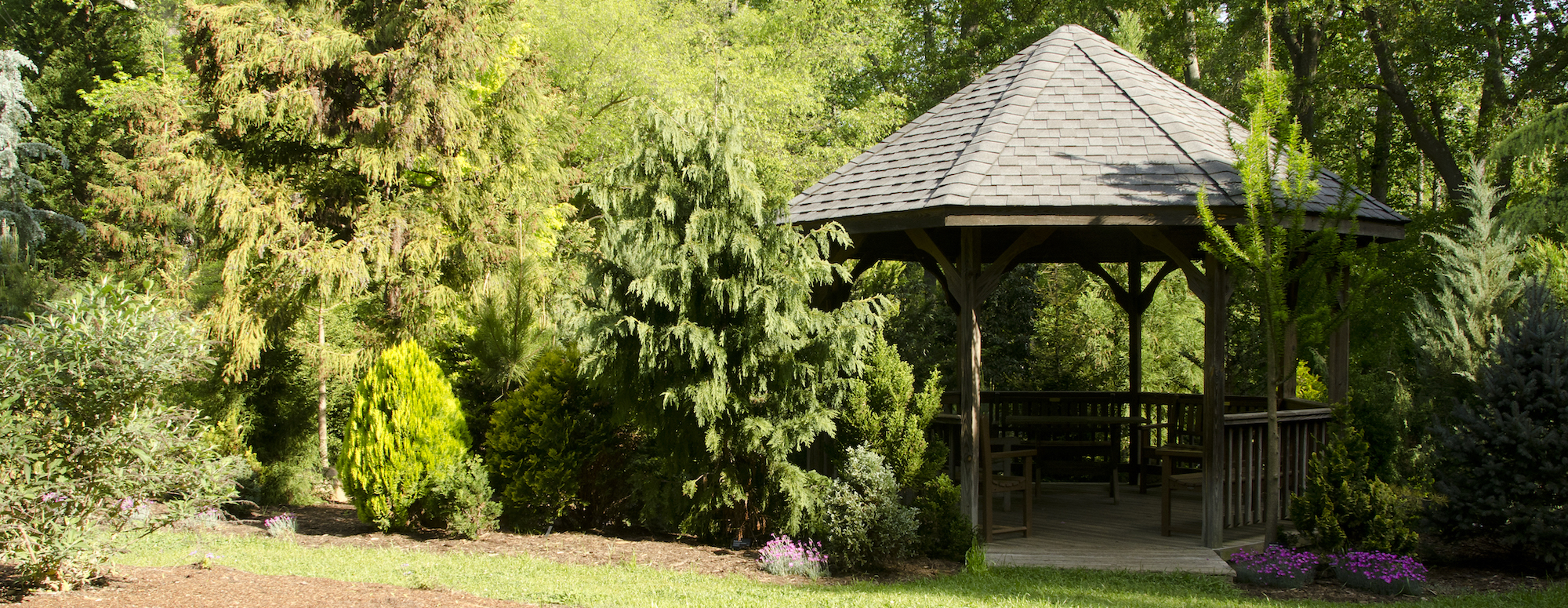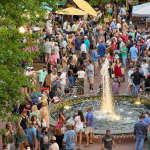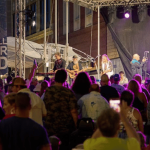The Gardens of Spartanburg
By Jan Scalisi , with the HubCity Writers Project.
You can drive by it on busy John B. White Sr. Boulevard and never notice it. You can even pull in and park at the entryway, but still have no clear idea of what’s ahead. It’s only as your walk unfolds, step by surprising step, that you begin to realize where you’ve arrived: in a peaceful garden in the middle of the city.
 Amazing how Spartanburg’s Hatcher Garden and Woodland Preserve makes visitors feel like they’ve made their own secret discovery. As the trails unwind through the 10 acres and reveal their borders of lush plantings and features that lie in wait around every turn, the city recedes and nature rushes in. Even the air smells green in the garden.
Amazing how Spartanburg’s Hatcher Garden and Woodland Preserve makes visitors feel like they’ve made their own secret discovery. As the trails unwind through the 10 acres and reveal their borders of lush plantings and features that lie in wait around every turn, the city recedes and nature rushes in. Even the air smells green in the garden.
The extraordinary sense of tranquility that characterizes my stroll through Hatcher Garden might be its most enduring accomplishment. Started in 1969 as a private garden by Harold Hatcher, who patiently acquired nearby lots adjoining his home and systematically cleared them for his wife Josephine to plant over 30 years, this place has maintained an aura of private serenity even after becoming a public garden in 1987.
Peaceful though it is, the garden is a dynamic place, especially in the spring. It’s thriving—with bushes, trees, and plants blossoming and blooming everywhere my eye can see. Tiny blooms, majestic trees, and flowering bushes overlay the green with splashes here and vistas there of riotous color. Squirrels race, birds chatter, turtles sunbathe, snakes slither, and everybody is attracted to the cool ponds and the surprising waterfalls.
For someone like me who has never had a garden, it’s a gentle education. Discreetly placed among the trails are signs that identify more than 900 of the plants, complete with the Latin genus and common names. Areas are devoted to one particular kind of plant—such as a Butterfly Garden, a Conifer Garden, a Wildflower Garden, a Hosta Garden. I wasn’t familiar with the plants that America’s first native-born naturalist William Bartram documented in his journey through the South in the 18th century, but I learned about them on Hatcher’s Bartram Trail with Native Plants.
 Still, there are places for people among the plants. A Garden of Healing and Hope provides a place for reflection for mourners of loved ones, dotted with features that include a sand garden for children, a bench for quiet counsel, and commemorative pavers (one says: “Love of Animals, Plants, Music and Shag Dancing. She’s gone to the beach!”) There’s a gazebo, a bridge overlooking a waterfall, picnic tables under a roof at the Jesse Taylor Pavilion, a natural amphitheater, and an open stretch of green. People get married at Hatcher Garden, and in fact, many events are held here, including annual fund-raisers. If you’re lucky like I was, you might stop in on a day when Boy Scouts or school kids are visiting, or when troops of volunteers are doing their good work in the garden. If your stars are fully aligned, you might happen by during a plant sale, where up to 5,000 plants grown in Hatcher’s greenhouses are sold to the public.
Still, there are places for people among the plants. A Garden of Healing and Hope provides a place for reflection for mourners of loved ones, dotted with features that include a sand garden for children, a bench for quiet counsel, and commemorative pavers (one says: “Love of Animals, Plants, Music and Shag Dancing. She’s gone to the beach!”) There’s a gazebo, a bridge overlooking a waterfall, picnic tables under a roof at the Jesse Taylor Pavilion, a natural amphitheater, and an open stretch of green. People get married at Hatcher Garden, and in fact, many events are held here, including annual fund-raisers. If you’re lucky like I was, you might stop in on a day when Boy Scouts or school kids are visiting, or when troops of volunteers are doing their good work in the garden. If your stars are fully aligned, you might happen by during a plant sale, where up to 5,000 plants grown in Hatcher’s greenhouses are sold to the public.
But for a long-time Spartanburg resident like me, one of the most striking features of Hatcher Garden is the number of volunteers and community organizations that have contributed to and continue to contribute to its flowering beauty—from local foundations, to hospice, garden clubs, philanthropic organizations, businesses, and many, many individuals who have found joy in working in, working on behalf of, or contributing to the secret garden in the middle of the city. It is those folks and many others like me who happily include Hatcher Garden on their list of must-see attractions for Spartanburg visitors because it’s special not only for its flora and fauna, but also for the love with which its community cares for it.
Like all things good, a garden can whet the appetite for another garden. There are more marvelous horticultural experiences to be enjoyed in the Spartanburg area, which boasts of four other arboretums, all free and open to the public. Spartanburg Community College’s Arboretum (I-85 Business at New Cut Road) has a marvelous collection of trees, shrubs, and perennials throughout the campus, plus a horticulture garden and several specialty niche gardens, including the only Outdoor Train Garden in the country. A scale model train runs along a 300-foot dogbone-shaped track, past miniature plantings and models of Spartanburg landmarks.
Much of the 650-acre headquarters at Milliken & Company (920 Milliken Road) serves as a testing ground for cultivating the best trees for the next generation, called Noble Trees, and features more than 3,000 trees that surround ponds and trails. Park on the frontage road and just wander. It’s particularly spectacular in the fall.
The Susan Jacobs Arboretum at the University of South Carolina Upstate (800 University Way) comprises a 300-seat amphitheater, a creek, lighted walkways, and indigenous foliage within its 12 acres. And finally, the entire Wofford College campus (429 North Church St.) is a designated arboretum, with more than 4,000 trees creating a feast for the eyes across 150 acres.
Jan Scalisi, Produced in cooperation with the HubCity Writers Project.
 Jan Scalisi is a freelance writer and editor who also serves on Spartanburg’s City Council. She loves her town, good books and good movies, dancing until the lights go off, and all kinds of design.
Jan Scalisi is a freelance writer and editor who also serves on Spartanburg’s City Council. She loves her town, good books and good movies, dancing until the lights go off, and all kinds of design.






